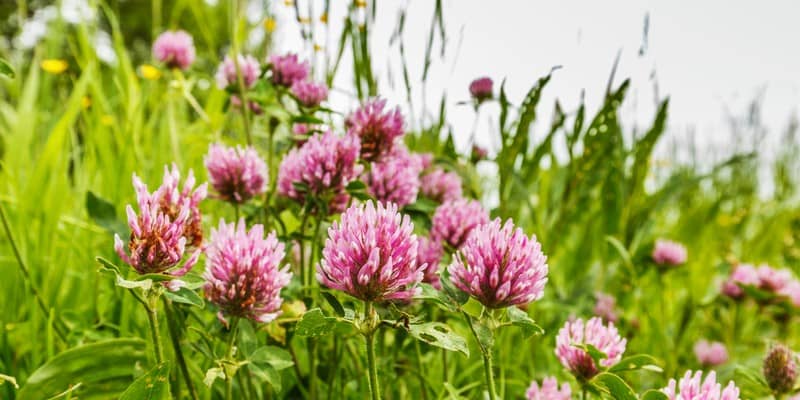Have you ever dug around a clover patch to find that elusive four-leaf clover? While a four-leaf supposedly brings luck, it’s a little less pleasant for your lawn. Clover is actually considered a broadleaf weed, and while it’s not too harmful, it may not be welcome either.
How to get rid of clover in the lawn? There are several methods, ranging from smothering the broadleaf weeds to spraying them with a mixture of vinegar and dish soap. Corn gluten meal and high NPK fertiliser are also popular methods for removing clover from lawn.
Ways to kill clover:
- Nitrogen-rich fertiliser
- Manual removal
- Corn gluten meal
- Vinegar and dish soap
- High mowing
- Organic weed killer
- Smothering
Four leafs might be lucky, but a clover problem could be bad news. Here’s how to eliminate clover naturally for healthy grass.
What is Clover?
Clover is actually part of the legume family – meaning it’s related to peanuts and soybeans. Unlike its cousins, though, we don’t usually eat clover leaves and seeds. This herbaceous plant has trifoliate leaves (and very rarely, quatrefoiled!).
Wild animals consume wild clover as food, especially birds and bears. It’s also widely cultivated as fodder.
Common types of clover you’ll find in your lawn include:
- White clover – Possibly the most common of all clover types. This low-growing, hardy species has white to pink florets.
- Red clover – This is taller and bushier than the white variety, with florets that are reddish in colour.
- Strawberry clover – Its appearance is similar to white clover, but with smaller pinkish florets.
Why Does Clover Grow On My Lawn?
Clover thrives when nitrogen levels are low, so seeing clover in your lawn might be a sign of a bigger problem. The plant draws nitrogen from the air and stores it in its roots, from which it gets released into the ground.
The presence of clover might also indicate that you’ve mown your lawn too short, or you’ve overwatered. Your soil quality might also be low, with an unbalanced pH.
How to Kill Clover in the Lawn
Proper lawn care (including regular mowing and moderate watering) will prevent clover from growing on your lawn. But if you’ve already got clumps of this broadleaf weed, here’s how to get rid of clover.
1. Nitrogen-rich fertiliser
Lawns love nitrogen, clover hates it.
A good organic fertiliser that’s rich in nitrogen can help restore the nutrient balance to your lawn and raise the nitrogen levels. Don’t use the slow-release variety – you’ll want to raise your nitrogen levels and deal with your clover problem quickly.
2. Manual removal
If you only have small patches of this common lawn weed, then you can simply uproot them! Gently loosen the soil around the base with a spade, then pull the clover out.
Ensure you get all the roots or the clover will grow back.
3. Corn gluten meal
Your local garden centres should carry this. Corn gluten meal inhibits clover growth by releasing organic peptides into the soil, which dry out clover seeds.
Spread 1.0 kg of corn gluten per 10 sqm, then water well. Let the corn gluten dry naturally.
4. Vinegar and dish soap
A natural remedy for clover weeds is vinegar and detergent! Add a few drops of dish detergent to vinegar in a spray bottle, then use that to spot-treat clumps of clover.
Make sure to avoid surrounding grass and other plants, though!
5. High mowing
While shorter grass growth is pleasing to look at, letting the grass grow a little long can help keep your lawn healthy. Clover grows low to the ground with a shallow root system, so it’s easily covered up.
Raise your mower deck so you leave the grass at least 7.0 cm high. This will block sunlight from reaching clover, which can prevent it from growing and spreading.
If you regularly use lawn mowing services, make sure you tell them about your preferred grass height!
6. Organic weed killer
Specifically, broadleaf herbicides or selective herbicides. These won’t harm surrounding grass, instead causing weeds to twist and die. Be mindful of applying these herbicides, however, since they could hurt certain plants.
For best results, use weed killer as a spot treatment directly on clover patches instead of a general lawn application.
7. Smothering
For isolated patches of clover, you can simply smother them. Stretch a rubbish bag or similar plastic sheeting over the patch and secure the corners. This will prevent water and sunlight from reaching the weeds, which will then die off.
Tips to Control Clover Growth
Once you’ve gotten rid of clover, sow grass seed on the bare patch. This will prevent clover seeds from germinating and also restore the appearance of your lawn.
Besides clover, make sure you get rid of grubs and mushrooms which could damage your lawn.
Keep your lawn well-aerated. Compacted soil is not ideal for grass growth, so aerate your lawn and keep the grass healthy.
Water your garden moderately – too much and the soggy conditions are prime for weeds, but too little and you’ll end up with thirsty grass.
Know that clover isn’t a death sentence for your lawn. Patches of clover reduce soil erosion, fix nitrogen levels, attract bees, and more. But of course, if you’re particular about your yard or the clover is starting to outgrow your grass – it’s time to learn how to get rid of clover in lawn!





